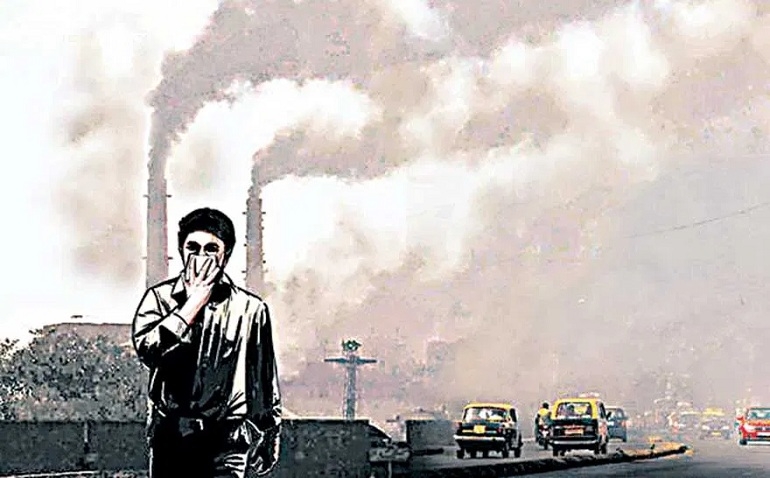New dashboard on NAMP reveals higher PM10 concentrations in 4 Vid cities
| Date :10-Nov-2020 |

By Kartik Lokhande :
Air pollution has been attracting some attention of policy-makers in the past few years, mainly because of its impact on public health. As far as norms relating to levels of particulate matter (PM) are concerned, four non-attainment cities in Vidarbha have recorded higher PM10 concentrations in three-year period since 2016. Of a total 122 non-attainment cities listed under National Clean Air Programme (NCAP), 18 are in Maharashtra. Of these 18 cities in Maharashtra, four are in Vidarbha. These four cities include Nagpur, Chandrapur, Akola, and Amravati.
CarbonCopy and Respirer Living Sciences have created a new dashboard, which was released last week. This dashboard presents a picture of PM pollution for all 122 non-attainment cities listed under NCAP over three years since 2016. It provides a comprehensive picture of India’s National Ambient Air Quality Standards (NAAQS) under National Air Quality Monitoring Programme (NAMP). The new dashboad reveals that though these four cities in Vidarbha have done well in number of readings, the PM10 concentrations are quite higher than norms. Also, there are data inconsistencies in case of Chandrapur. World Health Organisation (WHO) standard is 10 µg/m3 for average PM pollution.
Central Pollution Control Board (CPCB) standard is 40 µg/m3 for PM2.5 pollution and 60 µg/m3 for PM10 pollution. As per the new dashboard developed by CarbonCopy and Respirer Living Sciences, however, the PM10 levels in the above-mentioned four non-attainment cities of Vidarbha exceed 100 µg/m3, which is 10 times or more than WHO standard for average PM pollution. As per the dashboard, Maharashtra with maximum 18 non-attainment cities, installed PM2.5 monitoring at Mumbai and Nagpur, with just one monitor each. Most cities like Nagpur, Latur, Nashik, Pune, Sangli, and Solapur observed an increase in PM10 levels in 2018, in comparison to 2017 levels.
As far as non-attainment cities in Vidarbha are concerned, Chandrapur, which is one of the critically polluted clusters in the country, witnessed an ‘unexplained drop’ in PM10 levels in 2017. PM10 level in Chandrapur was 111 µg/m3 in 2016, but it fell to just 4 µg/m3 in 2017 and no explanation is available for that. In 2018, PM10 level in Chandrapur again rose to 149 µg/m3, which was higher than 2016 level. Barring Akola, which recorded in 2018 PM10 level of 72 µg/m3 (higher than CPCB norms), all other cities recorded PM10 levels between 100 µg/m3 and 149 µg/m3 in three years of study -- 2016, 2017, and 2018. The only saving grace was that these four non-attainment cities of Vidarbha recorded required level of manual monitoring readings across the three-year average.
CarbonCopy and Respirer Living Sciences had filed application under Right to Information (RTI) Act, as part of Budget Dashboard for the NCAP Tracker project. As per the reply to the application, Government has allocated Rs 40 crore to four non-attainment cities of Maharashtra namely Mumbai, Nagpur, Navi Mumbai, and Pune. Half of this budget is allocated for pollution clean-up activities, but Rs 11 crore of that half is allocated for mechanical street-sweepers. An amount of Rs 7.20 crore has been assigned to installation of six Continuous Ambient Air Quality Monitoring Stations (CAAQMS), and Rs 6 crore for pollution mitigation measures. The mitigation activities include electric/ gas based crematorium, proper collection, and disposal of horticultural waste and traffic synchronisation system.
About NCAP and NAMP Union Ministry of Environment, Forests and Climate Change notified NCAP on January 10, 2019 with an aim to reduce 20-30 per cent PM levels in 122 non-attainment cities by the year 2024, considering levels in 2017 as base levels. The non-attainment cities are those which failed to meet National Ambient Air Quality Standards for the period of 2011-15. NAMP has been running since 1984 (previously called National Ambient Air Quality Network). However, the publicly reported data on CPCB website is only available since 2016 till October 2019.
India has a network of 793 NAAQS covering 344 cities/towns in 29 States and 6 Union Territories. Under NAMP, four pollutants namely Sulphur Dioxide (SO2), Nitrogen Dioxide (NO2), suspended particulate matter (SPM), and respirable suspended particulate matter (RSPM) have been identified as key pollutants for regular monitoring. The monitoring is being carried out by State Pollution Control Boards and National Environmental Engineering Research Institute, Nagpur; and overseen by pollution control committees, CPCB and now by the Union Ministry of Environment under NCAP.
‘Look back, plan ahead’ The experts who head the organisations that have developed the dashboard stressed upon the need for ‘looking back to plan ahead’. Ronak Sutaria, Chief Executive Officer, Respirer Living Sciences, said that it was crucial to see the number of monitors available in each city while analysing the data. The increase or decrease of monitoring capacity year-on-year and the number of readings available per monitor every year were important.
“The fluctuations and inconsistency in this data will hugely impact the PM trends for any particular city and will reveal the true status,” he added. Aarti Khosla, Director, Climate Trends and Publisher for CarbonCopy, said that it was important to evaluate existing regulations as the first step towards effective crisis management. “NAMP dashboard allows us to look back and plan ahead,” she said. Noting that NAMP changed its data-capturing method after 2018 from recording PM levels to a composite Air Quality Index levels for 2019, Khosla said, “Standardisation of the data that is captured and made public is extremely crucial as that will provide the baseline to compare the progress being made till 2024.” She hoped that CPCB would make PM2.5 and PM10 data for 2019 and subsequent years also available.